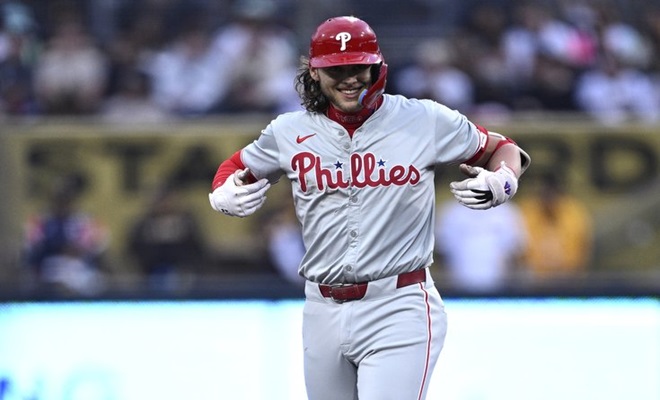-
 May 24, 2024, 5:18 am
May 24, 2024, 5:18 amLook, this week, we’re talking pause-uh-tiv-uh-tee. Positivity. Only the good this week. Next week we can be a little negative, focus on players whose stock has fallen. But this week, I want the sun shinin’, the birds singin’ and the stocks risin’.
We’ve got three hitters and three pitchers. Some post-hype prospect types, some young guns making some noise, a hitting-their-prime-and-having-a-career-year hitter and a record-setting pitching phanatic.
HITTERS
Alec Bohm is in the midst of a career year and no one is talking about it. Every year at the big league level he has been improving, lowering his strikeout rate from a career worst 26.6% in 2021 all the way down to 14.5% this year, raising his walk rate from a career low of 4.9% in 2022 to a full season career high of 7.7%, lowering his swing and swinging strike rates (47%, 6.1%, respectively) and raising his contact rate (87.1%). He leads all major leaguers in doubles, he’s tied for the RBI lead, seventh in hits, tied for fifth in batting average and is in the top fifteen for both on-base and slugging percentage. He gets to hit in the middle of an elite offense (he hits anywhere between second and fifth in the lineup, though he regularly bats cleanup), with All Star caliber players both ahead (Kyle Schwarber, JT Realmuto, Bryce Harper) and behind (Nick Castellanos, Bryson Stott) him in the lineup. And that’s with Trea Turner on the IL (in the three weeks they’ve been without their electric starting shortstop, the Phillies have actually scored 119 runs in 17 games, by far the most in all of baseball over that time frame).
Though he may not be getting to that elite power that scouts raved about when he was in college and during the draft process, he has been putting to good use his elite hit tool, spraying line drives all over the field. He’s sporting the second highest barrel rate and average exit velocity, the third best hard hit rate and the best launch angle of his career. Probably the only thing he doesn’t do that great is take a walk, though I do believe he could get that walk rate up closer to 9% if he keeps on improving. He may never be the 30 homer third baseman that fantasy managers are used to, but a 85-18-110-5-.305 end of season line is not out of the realm of possibilities, nor is the thought that he has a few more seasons like this after this one. He’s always been an incredible hitter, we’re just now getting to see him decide the kind of incredible hitter he wants to be.
Maikel Garcia was a very popular sleeper pick coming into the season and it seems like everyone who predicted a breakout (yours included), has been correct. Garcia joined Bobby Witt, Jr. on the left side of the infield in May of last year and is not going to leave it for the foreseeable future. Avoiding the sophomore slump so many tend to go through, Garcia has lowered his strikeout rate (from 22.3% to 17.7%), raised his swing and contact rates a bit (42.9% to 43.9% swing; 82% to 83.4% contact) and hit more flyballs (27.4% to 30.9%) with less ground balls (48% to 46.7%), all while being pitched more aggressively than he was as a rookie. He’s seeing more pitches in the zone (46.2%) and far more first pitch strikes (69.1%, up from 64.5%) than he did as a rookie, all while being more productive at the plate. Never known for his power, he has already surpassed his rookie home run total (four) this year (five) in nearly 300 less plate appearances. He’s nearly double his ISO from 0.086 to 0.163, thanks the surge in extra base hits (in 515 plate appearances last year he had 28 XBH; this year, he already has 20 through only 220 PA). He also has more than half as many stolen bases this year than he did last year (12 to 20) and will continue to be encouraged to run as the leadoff man for a surprisingly feisty Royals offense that has scored the third most runs in the majors. There’s no reason Garcia couldn’t score 85 runs, with 10 home runs, 60 RBI and 35 stolen bases while hitting around .260. That’s a top six or seven third baseman this year and going forward. I hope you were able to get in while everyone else was still sleeping on him, because everyone is wide awake to the talent and production now.
Imagine, if you will, if the Angels had gotten this version of Jo Adell at any point in the previous three seasons. This on-pace-for-30-home-runs-and-20-stolen-bases version of Adell, the one the Angels had hoped for when they drafted him tenth overall. The version they expected when he hit 20 home runs and stole 15 bases over three levels as a 19 year old in 2018. 2019 was lost a bit to an ankle sprain and hamstring strain, chalk up his 2020 rookie season to covid. But then, 2021, as a 22 year old in Triple-A, 23 home runs and eight stolen bases in only 339 plate appearances? We have him, the Angels brass thought, we have the third elite piece for our offense (at least when Trout is healthy). What did they get instead? A hotshot, hyped prospect who struggled at the big league level, striking out far too much and walking not enough. Same thing in 2022. Same for 2023. But then, this season rolls around. He still doesn’t walk enough, but he’s running more than he ever has at the big league level (his 13 stolen base attempts this season are more than the previous four seasons combined), he’s lowered his strikeout rate significantly (instead of the high 30’s or low 40’s, he is at 25.7%), because he is swinging at less pitches (48.2% swing rate is a career low), making more contact (72.4%) and has lowered his swinging strike rate quite a bit (from 18% last season to 13.3% this season). Along with that higher contact rate is better contact overall, with a higher barrel (14.3%) and hard hit rate (45.1%), career high line drive rate (22.2%) and far more contact on pitches outside than zone (63.9%) than ever before. The batting average may never be great and he probably won’t ever really walk a ton, but if he is going to hit 30 or more home runs and steal 20 or more bases, he’ll be joining a very small group of players who do that each year (only six players did that last year). It’s just too bad the breakout didn’t happen sooner. Maybe a three-headed attack for the Angels might have kept Shohei Ohtani on this side of town.
PITCHERS
Raise your hand if, before the season started, you nominated Ranger Suarez as your #1 pitcher in all of baseball for 2024. Yeah, doing a quick count, that seems about right: zero hands were up. Suarez is currently in the middle of a historic run, as one of just four players to start 9-0 through their first 10 starts with an ERA under 1.50 since earned runs became an official stat in 1912 (Juan Marichal in 1966; Walter Johnson and Cy Falkenburg in 1913). He’s the first Phillies pitcher to win nine consecutive starts since 1910 (Earl Moore) and has the third lowest ERA through a pitchers first 10 starts to begin the season in team history as well (Grover Cleveland had two season with a lower ERA through the first ten games: 1.24 in 1916 and 1.31 in 1915). He’s also one of only nine pitchers who, at any point in the season, have won nine consecutive starts while allowing seven earned runs or less (the other eight: Johan Santana, Blake Snell, Cal Eldred, Gaylord Perry, Steve Blass, Bob Gibson, Warren Spahn and Hoyt Wilhelm).
Making history aside, will it stick? Yes and no. For starters, he gets to pitch for the highest scoring offense and “best” team in all of baseball, the Phillies. Will he maintain a 1.36 ERA for the rest of the season? Probably not, but his FIP (2.54), xERA (2.31), xFIP (2.65) and SIERA (2.74) would have all been in the top three for 2023, so still elite. He strikes out just 9.27 batters per nine innings pitched with a 10% strikeout rate, both a little higher than his career averages, but right around his previous career highs in 2021 (9.08 and 11.3%, respectively). The biggest improvement he’s seen is that his walk rate has essentially halved, from 3.46 BB/9 in 2023 to 1.64 BB/9 this season, which is a career low by a full walk per nine. Can he maintain the gains in his walk rate? Maybe. He is throwing a first pitch strike 65% of the time, a career high, while also throwing strikes 65% of the time. Less balls thrown does mean less chances to walk someone. He has a pretty elite chase rate (33.2%, in the top 14% of pitchers) and a pretty low contact rate on pitches outside the zone (52.2%, second lowest of his career). Add to that an elite ground ball rate (55.6%, fifth out of all qualified starters) and you have a pretty good formula for an elite season. I don’t expect him to be the best pitcher in all of baseball once the season is done, but can he be a top 10 to 15 starter the rest of the year? I absolutely believe so. For a starting pitcher who was drafted, on average, after the first 300 players, that’s quite a return on your investment.
Coming into the season, I don’t think you could find one person who would have predicted that Luis Gil would be the pseudo-ace of the Yankees by the end of May. Yet, here we are, one week from the end of the month, and Gil is tied with two others for the team lead in wins (5; Clarke Schmidt and Carlos Rodon), leads the team in strikeout rate (11.39 K/9) and ERA (2.39) and is second in WHIP (1.08; Schmidt has a 1.07) and total strikeouts (62; Cortes has 63 in two starts and 16.2 innings more of work). He has an elite, 96 MPH fastball supported by two good to great off-speed pitches in his slider and change up (and is slowly working a cutter into the fold). He has command issues, walking 4.96 batters per nine innings pitched (and has struggled with command his entire career) and struggles to get hitters to chase his pitches out of the zone, but he offsets that a bit by attacking the strike zone (50.8% of his pitches are in the zone), inducing an elite whiff rate (30.8%, in the top 17% of pitchers) and limiting both barrels and hard hits. He’s managed to limit home runs, even though he calls Yankees Stadium his home field, allowing only three so far. He may not stay an elite pitcher throughout the entire year, as a player with his control issues will be prone to a few blow up games a year, but he should be treated as a top 30 starter and one of, if not the, best starters in the Bronx.
It’s incredible that Garrett Crochet was drafted in 2020, with the 11th overall pick, and, since then, has spent a whopping 12.1 innings in the minor leagues, and that was to rehab injuries. The White Sox threw him into the fire during the covid shortened 2020 season, where he struck out eight over six shutout relief innings. Then, in 2021, the Sox left him in the bullpen, to the tune of 54.1 innings, where he put up a pretty decent season: 12 holds, 3 wins, 65 strikeouts, 27 walks. 2022 was lost to the all to common injury we lose pitchers to, Tommy John. He struggled mightily last year, between recovering from TJS, shoulder inflammation and a couple of minor league rehab assignments, throwing only 12.2 innings in the majors, striking out only 12, walking a whopping 13 but allowing only one home run, all as a reliever. Which brings us to this season, the first time since drafting Crochet, that the Sox decided to let him go out there and see what he can do as a starter.
His first start, on March 28th, was the first time he had started a game since his junior year of college, in the spring of 2020. He went six innings, striking out eight batters and allowing only one earned run. Since then, he’s been off to the races, limiting opposing offenses to two earned runs or less in eight of his eleven starts (though, in those three starts, he allowed a combined 17 earned runs against the Reds, Phillies and Twins). He also allowed half of his eight home runs in those three games. In his eight other starts, he’s thrown 45 innings, allowed seven earned runs, struck out 55 and walked only six. He has the third best strikeout rate in baseball (11.55 K/9), solid chase and whiff rates, has limited barrels and hard hits and has about an average ground ball rate. He’s also currently on a 19 inning scoreless streak, hasn’t allowed a home run over his last three starts and has struck out 34 batters and walked only five in the five starts since Minnesota blew him up. The big question for Crochet is, how many innings will the Sox let him throw before they shut him down? He’s already thrown more innings this season than he has in any professional season prior. The Sox are not a good team, so no need to throw him out there to win more games and should not put him in a position to hurt himself…again. As a fantasy manager, you need to decide when the time is right to move him. If you are in a re-draft league and you’ve been blessed with these eleven starts, I would be trying to sell him as high as humanly possible right now. He might have 25 innings left or he might have 50 innings left. I’d rather be holding the pitcher that still has 90 or more innings left than the one who might be done by the end of June. If you are in a keeper or dynasty league, you need to decide if the cost to continue to roster essentially a hole in your roster is worth it for this season, to get the production from 2025 and beyond.

